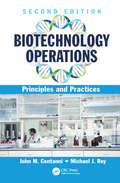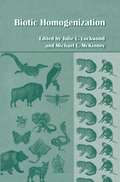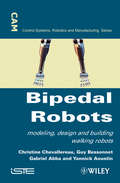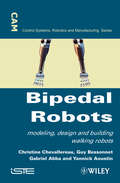- Table View
- List View
Biotechnology Operations: Principles and Practices, Second Edition
by John M. Centanni Michael J. RoyThis book describes seven areas in the field of biotechnology operations as practiced by biopharmaceutical firms and nonprofit institutions. Revisions focus upon changes that have occurred in several areas over the past six years, with emphasis on regulatory, biomanufacturing, clinical and technical information, along with processes and guidlines that have added to the discipline. Examples are increased for new technical fields such as cell and tissue engineering. Further, illustrations or figures are added to each chapter to emphasize particular points.
Biotechnology Policy across National Boundaries: The Science-Industrial Complex
by D. WestA globalization of innovation has produced the most massive spurt in biotechnology in world history. Businesses, universities, and non-governmental organizations are collaborating to produce a "science-industrial complex" in biotechnology. Using case studies of stem cell research, cloning, genetically modified food, in-vitro fertilization, and chimeras in a number of Eastern and Western countries around the world, I argue that much of this biotech activity is global in nature and independent of state control. This shift in the relative influence of state and non-state actors has led to the virtual deregulation of biotechnology and the liberation of innovation from geo-political constraints. These trends post a number of interesting social, political, and ethical issues for the contemporary period and suggest the need to rethink how controversial moral issues are handled by the science-industrial complex.
Biotechnology Products in Everyday Life (EcoProduction)
by Menka Khoobchandani Arpita SaxenaThis book explores a sampling of the most powerful and enterprising efforts to achieve biotechnological goals by means of various interdisciplinary approaches. From the fabrication of extremely small units to achieve specific objectives through nano-bio-technology, to devices with artificial intelligence, gene therapy for cerebrovascular anomalies, biodegradable plastics, the use of phyto-stem cells in cosmetology, CarT cell immune therapy, targeted therapies for cancer, 3D printed bones developed by the University of Wollongong in Australia, the sickle cell chip developed by IIT Bombay, and innovative sustainable energy solutions, the book includes a colorful spectrum of reviews on current and future biotech products. Gathering contributions by an international team of researchers, this book offers its audience, and particularly younger readers, revealing information on current and upcoming smart technologies.
Biotechnology & the Environment: International Regulation
by Iver P. Cooper Bruce F. Mackler Jeffrey N. GibbsBiotechnology to Enhance Sugarcane Productivity and Stress Tolerance
by Kalpana SengarSugarcane is the most important plant source for sugar and alcohol production and is cultivated in more than 80 countries in tropical and subtropical areas. However, environmental factors negatively influence its yield and jeopardize the prospect to meet the increasing demand for sugar, other sugarcane derived by products and bioethanol. The development of stress tolerant plants is fundamental for the maintenance and increase of crop yields. Biotechnology to Enhance Sugarcane Productivity and Stress Tolerance provides a comprehensive account of both theoretical and practical aspects of sugarcane production. It contains extensive coverage of genome mapping and molecular breeding in sugarcane and presents the status of the elucidation and improvement of plant genomes of economic interest. Through 14 chapters written by eminent scientists with global influence, this book examines various methods for sugarcane improvement through biotechnology. The book focuses on genetic and physical mapping, positioning, cloning, and monitoring of desirable genes using biotechnological approaches for high sugarcane productivity and the development of stress tolerance. Additional information includes the bioengineering of sugarcane, procedures to boost productivity, genetics and assessments for resistance to drought and salinity, genetics for high yields, and various topics of research on sugarcane genetics. It serves as a detailed reference source for cane growers, sugar and sugarcane technologists, students, and professors.
Biotechnology to Enhance Sugarcane Productivity and Stress Tolerance
by Kalpana SengarSugarcane is the most important plant source for sugar and alcohol production and is cultivated in more than 80 countries in tropical and subtropical areas. However, environmental factors negatively influence its yield and jeopardize the prospect to meet the increasing demand for sugar, other sugarcane derived by products and bioethanol. The development of stress tolerant plants is fundamental for the maintenance and increase of crop yields. Biotechnology to Enhance Sugarcane Productivity and Stress Tolerance provides a comprehensive account of both theoretical and practical aspects of sugarcane production. It contains extensive coverage of genome mapping and molecular breeding in sugarcane and presents the status of the elucidation and improvement of plant genomes of economic interest. Through 14 chapters written by eminent scientists with global influence, this book examines various methods for sugarcane improvement through biotechnology. The book focuses on genetic and physical mapping, positioning, cloning, and monitoring of desirable genes using biotechnological approaches for high sugarcane productivity and the development of stress tolerance. Additional information includes the bioengineering of sugarcane, procedures to boost productivity, genetics and assessments for resistance to drought and salinity, genetics for high yields, and various topics of research on sugarcane genetics. It serves as a detailed reference source for cane growers, sugar and sugarcane technologists, students, and professors.
Biotelemetrie: Angewandte biomedizinische Technik (Anaesthesiologie und Intensivmedizin Anaesthesiology and Intensive Care Medicine #78)
by H. HuttenBiothermodynamics: Principles and Applications
by Mustafa Ozilgen Esra Sorguven OnerOver the past several decades there has been increasing research interest in thermodynamics as applied to biological systems. This concerns topics such as muscle work and internal energy such as fat and starch. Applications of the first and second laws of thermodynamics to the human body are important to dieticians and health science experts, and applications of these concepts to the animal body are a major concern of animal scientists. This book covers these key topics, which are typically not covered in classic or traditional thermodynamics texts used in mechanical and chemical engineering.
Biotic Homogenization
by Michael L. McKinney Julie L. LockwoodBiological homogenization is the dominant process shaping the future global biosphere. As global transportation becomes faster and more frequent, it is inevitable that biotic intermixing will increase. Unique local biotas will become extinct only to be replaced by already widespread biotas that can tolerate human activities. This process is affecting all aspects of our world: language, economies, and ecosystems alike. The ultimate outcome is the loss of uniqueness and the growth of uniformity. In this way, fast food restaurants exist in Moscow and Java Sparrows breed on Hawaii. Biological homogenization qualifies as a global environmental catastrophe. The Earth has never witnessed such a broad and complete reorganization of species distributions.
Biotic Stress Management in Rice: Molecular Approaches
by Md. Shamim and K. N. SinghThis book, Biotic Stress Management in Rice: Molecular Approaches, addresses biotic stress of rice and its management through molecular approaches. It focuses on the biotechnological aspects of rice with the aim of reducing the fungicide and insecticides and ultimately ensuring safety of rice as a food as well as the environment. Rice is an important crop in much of the Asia-Pacific region, and there are a number of threats to rice production, including fungal, viral, and bacterial diseases and insect pests, both in temperate and tropical countries, which can cause the significant economic loss. Remarkable efforts are being made by scientists and breeders to raise rice productivity and safety by modifying and manipulating rice plants to survive under different types of stresses. The book provides an understanding of the genetic basis of resistance and susceptibility and goes on to present studies directed to understand the host-plant interaction in rice that have given rise to specialized breeding programs for resistance to diseases and insect-pests. In addition to these advancements in molecular breeding, marker-assisted selection and transgenic approaches open new ways to increase resistance in rice for better production under several biotic stresses. This book covers the most recent advancements and research strategies of molecular breeding, transgenic approaches, and other tools for effective biotic stress management in rice. This book should find a prominent place on the shelves of new plant breeders, biotechnologists, plant pathologists and entomologists working in academic and commercial rice research programs, and in the libraries of research establishments.
Biotic Stress Management in Rice: Molecular Approaches
by Shamim K. N. SinghThis book, Biotic Stress Management in Rice: Molecular Approaches, addresses biotic stress of rice and its management through molecular approaches. It focuses on the biotechnological aspects of rice with the aim of reducing the fungicide and insecticides and ultimately ensuring safety of rice as a food as well as the environment. Rice is an important crop in much of the Asia-Pacific region, and there are a number of threats to rice production, including fungal, viral, and bacterial diseases and insect pests, both in temperate and tropical countries, which can cause the significant economic loss. Remarkable efforts are being made by scientists and breeders to raise rice productivity and safety by modifying and manipulating rice plants to survive under different types of stresses. The book provides an understanding of the genetic basis of resistance and susceptibility and goes on to present studies directed to understand the host-plant interaction in rice that have given rise to specialized breeding programs for resistance to diseases and insect-pests. In addition to these advancements in molecular breeding, marker-assisted selection and transgenic approaches open new ways to increase resistance in rice for better production under several biotic stresses. This book covers the most recent advancements and research strategies of molecular breeding, transgenic approaches, and other tools for effective biotic stress management in rice. This book should find a prominent place on the shelves of new plant breeders, biotechnologists, plant pathologists and entomologists working in academic and commercial rice research programs, and in the libraries of research establishments.
Biotic Stress Management in Tomato: Biotechnological Approaches (Innovations in Horticultural Science)
by PhD And Md. Shamim Shashank Shekhar SolankeyThis valuable volume highlights biotechnological tools and their utilization for biotic stress management in the tomato plant, one of the world’s most important vegetable crops consumed by us in our daily diet and which is vulnerable to over 200 diseases as well as the impact of global climate change. The chapters cover the major diseases of tomato along with practical biotic stress management strategies through biotechnological and molecular approaches. The focus is on molecular tools that can be used to prevent or mitigate damage from such diseases as bacterial wilt, bacterial canker, damping off seedlings, late blight, early blight, fusarium wilt, septorial leaf spot, cercospora leaf spot, verticilium wilt, tomato leaf curl virus, tobacco mosaic virus, tomato spotted wilt virus, root knot nematode, fruit borer, and sucking pests. Gene stacking/pyramiding and postharvest management strategies are also systematically discussed. This book provides an up-to-date and comprehensive review that will be a greatly useful resource, containing basic facts and information on the new and recent discoveries for biotic stresses management of tomatoes.
Biotic Stress Management in Tomato: Biotechnological Approaches (Innovations in Horticultural Science)
by Shashank Shekhar Solankey ShamimThis valuable volume highlights biotechnological tools and their utilization for biotic stress management in the tomato plant, one of the world’s most important vegetable crops consumed by us in our daily diet and which is vulnerable to over 200 diseases as well as the impact of global climate change. The chapters cover the major diseases of tomato along with practical biotic stress management strategies through biotechnological and molecular approaches. The focus is on molecular tools that can be used to prevent or mitigate damage from such diseases as bacterial wilt, bacterial canker, damping off seedlings, late blight, early blight, fusarium wilt, septorial leaf spot, cercospora leaf spot, verticilium wilt, tomato leaf curl virus, tobacco mosaic virus, tomato spotted wilt virus, root knot nematode, fruit borer, and sucking pests. Gene stacking/pyramiding and postharvest management strategies are also systematically discussed. This book provides an up-to-date and comprehensive review that will be a greatly useful resource, containing basic facts and information on the new and recent discoveries for biotic stresses management of tomatoes.
Biotic Stress Management of Crop Plants using Nanomaterials (Advances in Bionanotechnology)
by Krishna Kant Mishra Santosh KumarThis book summarizes nanotechnology-based agricultural research for crop productivity and the management of various plant pathogens. It deals with the application of nano-molecules for quick, cost-effective, and precise plant disease diagnostic procedures, plant pests and disease management, nano-pesticides, and nano-diagnostics. Further, it explains nanomaterials for biotic stress management, with an insight into the synthesis and modification of nanomaterials and their potential applications in different domains for disease management. Features include:• Compilation of current research on the Nanomaterials as well as their versatile applications in plant biotic stress management.• Description of the role of nanomaterials as enzyme-mimicking nanoparticles, nano-pesticides, nano-fertilizers, and nanomaterials.• Review of day-to-day problems related to crop plants, their diagnostics, and stress management.• Exploration of trends in nanomaterial utility in diagnostics, enzyme-mimicking, and crop protection, and their possible role in plant disease management.• Study of pertinent nanomaterials including synthetic strategies, properties, chemistry, and applications. This book is aimed at researchers and graduate students in plant pathology, genetic engineering, environmental science, botany, bioengineering, and nanotechnology.
Biotic Stress Management of Crop Plants using Nanomaterials (Advances in Bionanotechnology)
This book summarizes nanotechnology-based agricultural research for crop productivity and the management of various plant pathogens. It deals with the application of nano-molecules for quick, cost-effective, and precise plant disease diagnostic procedures, plant pests and disease management, nano-pesticides, and nano-diagnostics. Further, it explains nanomaterials for biotic stress management, with an insight into the synthesis and modification of nanomaterials and their potential applications in different domains for disease management. Features include:• Compilation of current research on the Nanomaterials as well as their versatile applications in plant biotic stress management.• Description of the role of nanomaterials as enzyme-mimicking nanoparticles, nano-pesticides, nano-fertilizers, and nanomaterials.• Review of day-to-day problems related to crop plants, their diagnostics, and stress management.• Exploration of trends in nanomaterial utility in diagnostics, enzyme-mimicking, and crop protection, and their possible role in plant disease management.• Study of pertinent nanomaterials including synthetic strategies, properties, chemistry, and applications. This book is aimed at researchers and graduate students in plant pathology, genetic engineering, environmental science, botany, bioengineering, and nanotechnology.
Biotransport: Principles and Applications
by Robert J. Roselli Kenneth R. DillerIntroduction to Biotransport Principles is a concise text covering the fundamentals of biotransport, including biological applications of: fluid, heat, and mass transport.
Biotribology: Emerging Technologies and Applications (Emerging Materials and Technologies)
by T. V. V. L. N. Rao Salmiah Binti Kasolang Xie Guoxin Jitendra Kumar Katiyar Ahmad Majdi Abdul RaniBiotribology includes tribological phenomena of natural and implant surface interactions under relative motion in the human body. Biotribology: Emerging Technologies and Applications disseminates ideas and research trends in biotribology and presents pioneering recent research advances impacting the field, focusing on the roles of mathematics, chemistry, physics, materials, and mechanical engineering. Discusses lubrication of joint replacements, computational modeling of biotribology and multibody biomechanical models Describes metal-organic frameworks, medical friction pairs, and electrochemical techniques to tribocorrosion tests Covers state of the art and future technological developments and applications, as well as challenges and opportunities Biotribology is an important and growing field, and the topics covered in this book will be of great interest to the international tribology community, appealing to readers working in the fields of materials science, biomedical engineering, biotechnology, mechanical engineering, and related areas.
Biotribology: Emerging Technologies and Applications (Emerging Materials and Technologies)
by T.V.V.L.N. Rao Salmiah Binti Kasolang Xie Guoxin Jitendra Kumar Katiyar Ahmad Majdi Abdul RaniBiotribology includes tribological phenomena of natural and implant surface interactions under relative motion in the human body. Biotribology: Emerging Technologies and Applications disseminates ideas and research trends in biotribology and presents pioneering recent research advances impacting the field, focusing on the roles of mathematics, chemistry, physics, materials, and mechanical engineering. Discusses lubrication of joint replacements, computational modeling of biotribology and multibody biomechanical models Describes metal-organic frameworks, medical friction pairs, and electrochemical techniques to tribocorrosion tests Covers state of the art and future technological developments and applications, as well as challenges and opportunities Biotribology is an important and growing field, and the topics covered in this book will be of great interest to the international tribology community, appealing to readers working in the fields of materials science, biomedical engineering, biotechnology, mechanical engineering, and related areas.
Biovalorisation of Liquid and Gaseous Effluents of Oil Refinery and Petrochemical Industry (IHE Delft PhD Thesis Series)
by Samayita ChakrabortyA bidirectional approach of detoxifying the liquid and gaseous effluents of oil refineries is elucidated in this thesis. Liquid effluents of oil refineries contain selenium oxyanions and phenol, while gaseous effluents contain CO/syngas. To remove the phenol and simultaneously reduce the selenite oxyanions, a fungal-bacterial co-culture of Phanerochaete chrysosporium and Delftia lacustris was developed. Two modes of co-cultures of the fungus and the bacterium were developed. Both cultures were investigated for phenol degradation and selenite reduction. In order to valorize the CO/syngas by bioconversion techniques. an anaerobic methanogenic sludge was acclimatized to use CO as the sole carbon substrate to produce acetic acid, butyric acid, and hexanoic acid. Later, the acids were metabolized at lower pH, producing alcohols ethanol, butanol and hexanol, confirming the successful enrichment strategy. The next experiment focused on the absence of the trace element tungsten, and consecutively selenium on the previously CO acclimatized sludge under the same operating conditions. An in-situ synthesized co-polymeric gel of N-ter-butyl-acrylamide and acrylic acid was used to recover ethanol, propanol and butanol from a synthetic fermentation broth. The scope of repeated use of the gel for alcohol recovery was investigated and 98% alcohol was recovered.
Biovalorisation of Liquid and Gaseous Effluents of Oil Refinery and Petrochemical Industry (IHE Delft PhD Thesis Series)
by Samayita ChakrabortyA bidirectional approach of detoxifying the liquid and gaseous effluents of oil refineries is elucidated in this thesis. Liquid effluents of oil refineries contain selenium oxyanions and phenol, while gaseous effluents contain CO/syngas. To remove the phenol and simultaneously reduce the selenite oxyanions, a fungal-bacterial co-culture of Phanerochaete chrysosporium and Delftia lacustris was developed. Two modes of co-cultures of the fungus and the bacterium were developed. Both cultures were investigated for phenol degradation and selenite reduction. In order to valorize the CO/syngas by bioconversion techniques. an anaerobic methanogenic sludge was acclimatized to use CO as the sole carbon substrate to produce acetic acid, butyric acid, and hexanoic acid. Later, the acids were metabolized at lower pH, producing alcohols ethanol, butanol and hexanol, confirming the successful enrichment strategy. The next experiment focused on the absence of the trace element tungsten, and consecutively selenium on the previously CO acclimatized sludge under the same operating conditions. An in-situ synthesized co-polymeric gel of N-ter-butyl-acrylamide and acrylic acid was used to recover ethanol, propanol and butanol from a synthetic fermentation broth. The scope of repeated use of the gel for alcohol recovery was investigated and 98% alcohol was recovered.
Biowaste and Biomass in Biofuel Applications (Mathematical Engineering, Manufacturing, and Management Sciences)
by Yashvir Singh Vladimir Strezov Prateek NegiThis book reflects the new dimension of biofuel production from its introductory principles to the advancements from a future prospective. It summarizes the rationale for changes in liquid fuel utilization and the selection of new technologies to make biofuel cost-effective and move toward a carbon-neutral approach. It provides an evidence-based outline of how additives and nanotechnology chemically change biofuels' quality and effectiveness, including new and innovative approaches, such as nanomaterials and various nano-additives. Features: It provides an overview of biowaste as a sustainable source in the field of biofuel production It includes effective conversion parameters of the biowaste feedstocks and their classification It summarizes current research into the development and exploitation of new biofuel sources It discusses the improvement of pilot scale scalability, chemical processing, and design flow It presents relevant and realistic global explanations of biowaste management techniques for biofuels This book is aimed at senior undergraduate and graduate students, and researchers in bioprocessing, chemical engineering, and biotechnology.
Biowaste and Biomass in Biofuel Applications (Mathematical Engineering, Manufacturing, and Management Sciences)
by Yashvir Singh Vladimir Strezov Prateek NegiThis book reflects the new dimension of biofuel production from its introductory principles to the advancements from a future prospective. It summarizes the rationale for changes in liquid fuel utilization and the selection of new technologies to make biofuel cost-effective and move toward a carbon-neutral approach. It provides an evidence-based outline of how additives and nanotechnology chemically change biofuels' quality and effectiveness, including new and innovative approaches, such as nanomaterials and various nano-additives. Features: It provides an overview of biowaste as a sustainable source in the field of biofuel production It includes effective conversion parameters of the biowaste feedstocks and their classification It summarizes current research into the development and exploitation of new biofuel sources It discusses the improvement of pilot scale scalability, chemical processing, and design flow It presents relevant and realistic global explanations of biowaste management techniques for biofuels This book is aimed at senior undergraduate and graduate students, and researchers in bioprocessing, chemical engineering, and biotechnology.
Biped Locomotion: Dynamics, Stability, Control and Application (Communications and Control Engineering #7)
by Miomir Vukobratovic Branislav Borovac Dusan Surla Dragan StokicHere for the first time in one book is a comprehensive and systematic approach to the dynamic modeling and control of biped locomotion robots. A survey is included of various approaches to the control of biped robots, and a new approach to the control of biped systems based on a complete dynamic model is presented in detail. The stability of complete biped system is presented for the first time as a highly nonlinear dynamic system. Also included is new software for the synthesis of a dynamically stable walk for arbitrary biped systems, presented here for the first time. A survey of various realizations of biped systems and numerous numerical examples are given. The reader is given a deep insight into the entire area of biped locomotion. The book covers all relevant approaches to the subject and gives the most complete account to date of dynamic modeling, control and realizations of biped systems.
Bipedal Robots: Modeling, Design and Walking Synthesis
by Christine Chevallereau Gabriel Abba Yannick Aoustin Guy BessonnetThis book presents various techniques to carry out the gait modeling, the gait patterns synthesis, and the control of biped robots. Some general information on the human walking, a presentation of the current experimental biped robots, and the application of walking bipeds are given. The modeling is based on the decomposition on a walking step into different sub-phases depending on the way each foot stands into contact on the ground. The robot design is dealt with according to the mass repartition and the choice of the actuators. Different ways to generate walking patterns are considered, such as passive walking and gait synthesis performed using optimization technique. Control based on the robot modeling, neural network methods, or intuitive approaches are presented. The unilaterality of contact is dealt with using on-line adaptation of the desired motion.
Bipedal Robots: Modeling, Design and Walking Synthesis (Iste Ser. #28)
by Christine Chevallereau Guy Bessonnet Gabriel Abba Yannick AoustinThis book presents various techniques to carry out the gait modeling, the gait patterns synthesis, and the control of biped robots. Some general information on the human walking, a presentation of the current experimental biped robots, and the application of walking bipeds are given. The modeling is based on the decomposition on a walking step into different sub-phases depending on the way each foot stands into contact on the ground. The robot design is dealt with according to the mass repartition and the choice of the actuators. Different ways to generate walking patterns are considered, such as passive walking and gait synthesis performed using optimization technique. Control based on the robot modeling, neural network methods, or intuitive approaches are presented. The unilaterality of contact is dealt with using on-line adaptation of the desired motion.

















